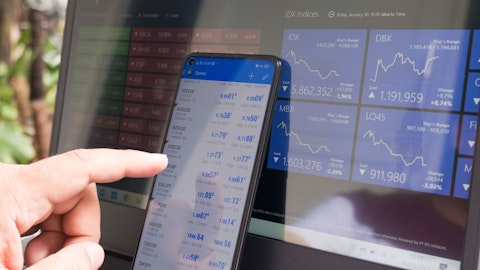Jeffrey Zekauskas: Thanks very much. I have a question on your Specialties forecast. For next year, you — at the midpoint, you assume EBITDA is about the same and revenues are about flat. And last year in the first quarter, I think, your Specialties EBITDA was something like $162 million and maybe you finished the year at something close to $30 million. How can you get to flat EBITDA as a base case?
Netha Johnson: Yeah. Hi, Jeff. This is Netha. I think if you look at the way we are projecting, the way pricing plays out throughout the year, you are right. The first quarter will be a little bit challenging on a year-over-year comparison standpoint. We still saw the numbers you saw, which was about a 60% growth in Q1 last year. The decline from that was really, really steep, driven by pricing. If you play that out on an annual basis for us, we think we can get back to where we were last year with maybe some upside or downside based on the ranges we provided with the pricing we expect to see going forward, and as Neal stated, that really is about a second half ramp in market volume and market pricing that we see coming and it’s really driven by how we look at the forward indicators with semiconductors, which for us is a good proxy for electronics already up 25% in the first quarter alone.
Jeffrey Zekauskas: Okay. And then for my follow-up, can you talk about what your either cash flow expectations are this year or free cash flow expectations for 2024?
Neal Sheorey: Yeah. Hi. I’m sorry, Jeff.
Jeffrey Zekauskas: Sure.
Neal Sheorey: Sorry. So this is Neal. Jeff, good morning. So, yes, we have obviously several things that are in motion right now with regards to our cash flow and I just want to put a finer point on what we’re working on with regards to operating cash flow. Obviously, we’ve already mentioned that we are working hard on aligning our own OpEx to the current pricing in the market. We’re also working on several operational things from a working capital perspective. You should expect in a deflationary environment that we should continue to release cash from working capital. And additionally, we’re looking for other levers that we can pull to further reduce inventory in our network. For example, investors are well aware that we have a long time between the mine and the customer in our natural supply chain.
So we’re looking for ways that we can reduce that and harvest cash from there. And then, of course, from a free cash flow standpoint, we’re reducing CapEx, as Kent mentioned earlier. In addition to that, we also have what I call non-operational cash flow items that we’re working on. This is things such as looking at what we can do with our working capital balances and generating financing from that. Now, all of that said, I realize that, some people may want a rule of thumb of how to think about this. So if you think about things from a cash conversion standpoint, and obviously, it will depend on what your lithium scenario is, but a cash conversion, if you look over the last three years or four years, this company has averaged a conversion of about 50%, plus or minus 10%.
So that’s one example that you can use to think about how to model operating cash flow.
Jeffrey Zekauskas: Great. Thank you very much.
Operator: Your next question comes from a line of Vincent Andrews from Morgan Stanley. Your line is open.
Vincent Andrews: Thank you very much and good morning. Maybe just following up on that, just looking at the balance sheet at the year end, your receivables are up year-over-year, your inventory is up year-over-year, your payables are about flat and that’s in a — obviously, the lithium price ended the year much lower at the end of 2023 than it did at the end of 2022. So what’s the bridge on that that caused that working capital to build despite the lower prices?
Neal Sheorey: Yeah. Good morning, Vincent. So it’s a few things. I think one of the important ones with regard to inventory is, remember that we have several assets that are in startup. So there has been a natural build in inventory through 2023 and you will continue to see that to some extent in 2024 as we build that inventory and work through the commissioning and startup of these new facilities that we have around the world. Remember, too, that there’s a timing aspect to this as well and so you have the timing of shipment and how that flows through our working capital, and so when you look at an end of year punctual period, you won’t necessarily see the impact of the timing of those shipments and so when we take a snapshot at the end of the year, it might not accurately reflect sort of the lag that we have in our supply chain.
But just to link your question, Vincent, also to what Jeff just asked, as you think about whatever your lithium price scenario is, and as you think about working capital cash release in 2024, depending on the scenario that you pick, if you use the scenarios we put in our deck, we’re looking at a sales decline of somewhere between $2 billion to $4 billion, depending on the scenario, and historically, we use a rule of thumb here at the company that working capital is around 25% of sales. So you should expect in 2024 that we can release cash to the tune of $500 million to $1 billion, depending, of course, on how those scenarios evolve in 2024.
Vincent Andrews: That’s very helpful. Thank you. And Kent, can I just ask you to refresh us on what return on invested capital you’re looking for when you put CapEx to work in the Energy Storage business and I don’t know if you want to define it differently by geography, but just sort of what those rough hurdle rates are and if they’ve evolved at all over the last few years, given the price movement.
Kent Masters: Yeah. So we — I mean, we kind of have a benchmark that we use to where we say at trough pricing, we want to get our cost of capital and double that at kind of the mid-cycle pricing. So now those numbers have moved around on us, but that’s kind of our — still our aim when we do projects is, when we look at it at what we believe is trough pricing, that that would generate a cost of capital and then kind of twice that at mid-cycle pricing — average pricing.
Vincent Andrews: Thanks very much, guys.
Operator: Your next question comes from a line of David Begleiter from Deutsche Bank. Your line is open.
David Begleiter: Thank you. Good morning, and Neal, welcome aboard. Kent and Eric, Energy Storage EBITDA guidance, if you were to mark-to-market that guidance to current prices, assuming no change in prices for the rest of the year, how much lower would your EBITDA guidance be for Energy Storage?
Eric Norris: Yeah. Hi, David. Good morning. Look, I think we’ve provided the numbers here for people to interpolate as they would like to between these different lithium price scenarios and so you can do your interpolation based on what you think the market price is at the moment. The only caution that I would give you as you think about a lower price scenario, which I think is where your question is getting at is and you can see this in our scenarios, as you get to these levels, it’s not unreasonable to think you’re bumping into some of the floors that we have in our contracts and those are at varying price levels, but you will see that in the math of our scenario. So I wouldn’t necessarily take that interpolation one for one if you’re going down further than the scenarios we’ve given.
David Begleiter: Understood. And Eric, just on lepidolite production in China, how much do you think has been shut in? How much do you expect to be shut in? Why has there not been more shut-in up until now for lepidolite production in China?
Eric Norris: Well, thanks for the question, David. A couple of things I’d say. When we look at shut-in capacity or capacity that’s exited the market in general and a big chunk of it is lepidolite, but some of also non-integrated spodumene and some of it is spodumene itself that’s come offline or is about to come offline because it’s very high cost, it’s above current spodumene costs even or prices rather or the cost is above current spodumene prices. But that is about 200,000 tons in total that has come off. Lepidolite is probably close to maybe a third to a half of that, somewhere in that range. The non-integrated lepidolite production has come off. Some of the integrated lepidolite production that is of weaker grade is well below — the price is well below the cash cost of that.
It’s very hard for us to — we know that, we know what the economics are, we can’t necessarily understand why some of it’s there. It’s still operating, because otherwise it should be — our math tells us it should be coming offline. So we can’t quite understand what’s going on there, but there’s still quite a bit, there’s still some capacity in the market that’s, well, like I said, at current prices, cost is well above those prices.
David Begleiter: Thank you.
Operator: Your next question comes from a line of Joel Jackson from BMO Capital Markets. Your line is open.
Joel Jackson: Hi guys. I’m not sure it’s Joe Jackson. So I wanted to ask a question about some of your sales guns for Energy Storage. If I take your guide, it’s $15,000 a ton, 10% to 20% more volume than the 150,000 tons you did Energy Storage last year. That would imply sales just a bit below $3 billion, maybe $2.9 billion for Energy Storage for this year. We’re going to, I think, $3.3 billion or something like that. What is the $400 million or $500 million difference in sales? Is that an accounting thing, spodumene, can you explain it, please?
Neal Sheorey: Hi there, Joel. No. It is not an accounting thing. I am wondering what volumes you’re using, because the ranges that we set here in our scenarios are based on the range of volumes that we’ve put here on the slide, slide eight in our deck and so we’ve adjusted the ranges based on that. So there’s definitely no accounting noise in that revenue number. Additionally, I should say this, too. Maybe this explains it. Just remember that for Energy Storage in total, there are other products that are in Energy Storage that don’t necessarily move one for one with lithium market price. So maybe that’s another piece of what is in your math as well.





